InfoCube Design Alternative II-Dimension Characteristics
In this section, we discuss yet another design alternative. This time, we will create a new IO_SREP, called IO_SREPN2. We will treat IO_SREG and IO_SOFF as independent characteristics, just like IO_SREPN2, and put them all together in the same dimension. Figure 7.3 shows a simplified star schema for this design.
Figure 7.3. BW STAR SCHEMA OF ALTERNATIVE II INFOCUBE DESIGN
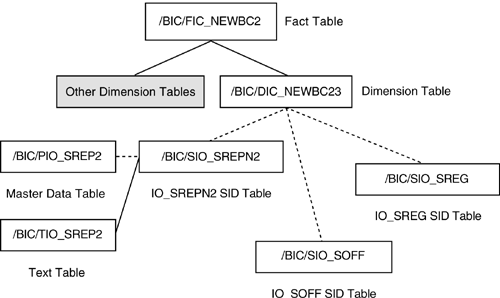
In Figure 7.3, /BIC/SIO_SREG and /BIC/SIO_SOFF have their own master data table and text table. These tables are not shown in the figure.
This design methodology is known as the Dimension Characteristics method. The following steps explain how to build this new design.
Work Instructions
Step 1. Repeat the Steps in Section 2.3 to create IO_SREPN2. It has no hierarchies.
SCREEN 7.22
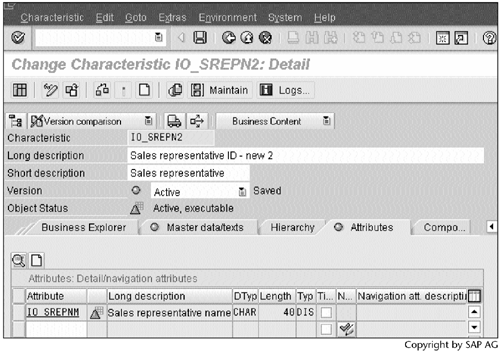
Step 2. Create an InfoCube and include IO_SREG and IO_SOFF as characteristics.
SCREEN 7.23

Step 3. Assign IO_SREG, IO_SOFF, and IO_SREPN2 to the same dimension as shown in this screen. (See Screen 2.27 for the difference.)
Click  to check the new InfoCube. If it is valid, click
to check the new InfoCube. If it is valid, click  to activate the new InfoCube.
to activate the new InfoCube.
SCREEN 7.24
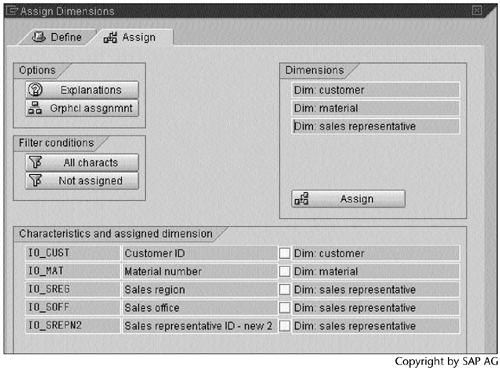
Step 4. We also need to include IO_SREG and IO_SOFF in the communication structure. (See Screen 3.52 for the difference.)
SCREEN 7.25
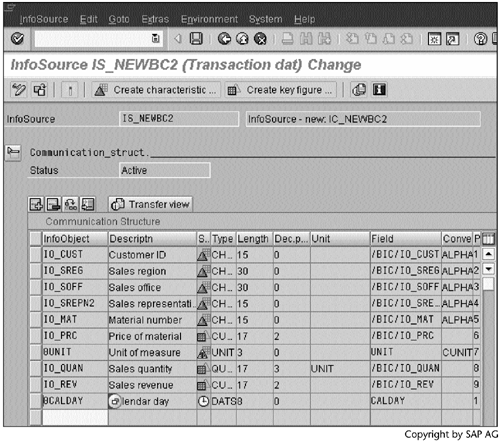
Step 5. Load data into the new InfoCube and create a query.
In the left panel, we see the three characteristics Sales office, Sales region, and Sales representative. They are all in the same dimension.
SCREEN 7.26
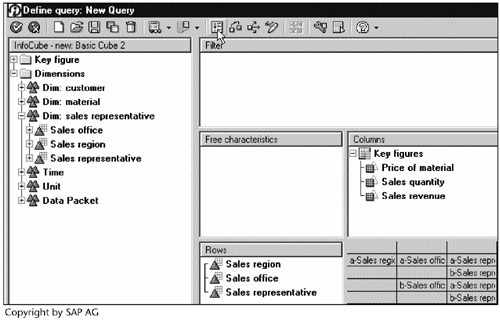
Step 6. As before, we specify 31.12.9999 as the key date, and run the query.
SCREEN 7.27
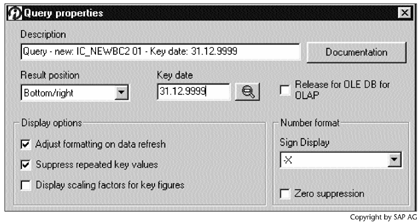
Result
Screen 7.28 shows the query result. The Denver office is listed under the Midwest region, instead of the West region, although we specified 31.12.9999 as the key date. This result arises because the sales transactions conducted by the Denver office all took place before January 1, 2000 (see Table 1.4). In the data warehousing world, this query result is referred to as a yesterday-or-today scenario – the data were valid when they were generated.
In a yesterday-and-today scenario, the data that were valid yesterday and today are displayed. In our example, we would not see the Denver office data in a yesterday-and-today scenario. For further information on this scenario, refer to ASAP for BW Accelerator, "Multi-Dimensional Modeling with BW."
Now we know that our new InfoCube design does not provide the two views of data that we saw earlier with the time-dependent hierarchy structure and time-dependent navigational attributes – namely, the today-is-yesterday scenario and the yesterday-is-today scenario.
SCREEN 7.28
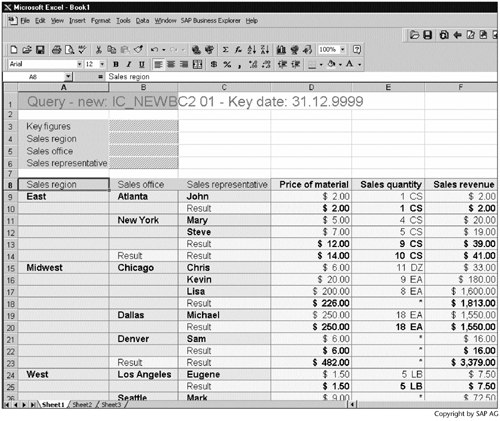
Note
From a performance point of view, this design improves upon the two earlier options, because it places IO_SREG and IO_SOFF closer to the fact table.
Performance is, of course, one of the major concerns in data warehousing. Here are some guidelines for dealing with this issue:
- If IO_SREG and IO_SOFF data are included in the transaction data, as shown in Table 7.1, use IO_SREG and IO_SOFF as dimension characteristics instead of characteristic attributes.
| IO_CUST | IO_SREG | IO_SOFF | IO_SREPN2 | IO_MAT | IO_PRC | 0UNIT | IO_QUAN | IO_REV | 0CALDAY |
|---|---|---|---|---|---|---|---|---|---|
| CUST001 | EAST | ATLANTA | SREP01 | MAT001 | 2 | CS | 1 | 2 | 19980304 |
| CUST002 | EAST | NEW YORK | SREP02 | MAT002 | 2 | CS | 2 | 4 | 19990526 |
| CUST002 | EAST | NEW YORK | SREP02 | MAT003 | 5 | CS | 3 | 15 | 19990730 |
| CUST003 | EAST | NEW YORK | SREP03 | MAT003 | 5 | CS | 4 | 20 | 20000101 |
| CUST004 | MIDWEST | DALLAS | SREP04 | MAT004 | 50 | EA | 5 | 250 | 19991023 |
| CUST004 | MIDWEST | DALLAS | SREP04 | MAT005 | 100 | EA | 6 | 600 | 19980904 |
| CUST004 | MIDWEST | DALLAS | SREP04 | MAT005 | 100 | EA | 7 | 700 | 19980529 |
| CUST005 | MIDWEST | CHICAGO | SREP05 | MAT006 | 200 | EA | 8 | 1600 | 19991108 |
| CUST006 | MIDWEST | CHICAGO | SREP06 | MAT007 | 20 | EA | 9 | 180 | 20000408 |
| CUST007 | MIDWEST | CHICAGO | SREP07 | MAT008 | 3 | DZ | 10 | 30 | 20000901 |
| CUST007 | MIDWEST | CHICAGO | SREP07 | MAT008 | 3 | DZ | 1 | 3 | 19990424 |
| CUST008 | MIDWEST | DENVER | SREP08 | MAT008 | 3 | DZ | 2 | 6 | 19980328 |
| CUST008 | MIDWEST | DENVER | SREP08 | MAT009 | 2 | CS | 3 | 6 | 19980203 |
| CUST008 | MIDWEST | DENVER | SREP08 | MAT010 | 1 | LB | 4 | 4 | 19991104 |
| CUST009 | WEST | LOS ANGLES | SREP09 | MAT011 | 1.5 | LB | 5 | 7.5 | 20000407 |
| CUST010 | WEST | SEATTLE | SREP10 | MAT011 | 1.5 | LB | 6 | 9 | 20000701 |
| CUST010 | WEST | SEATTLE | SREP10 | MAT011 | 1.5 | LB | 7 | 10.5 | 19990924 |
| CUST010 | WEST | SEATTLE | SREP10 | MAT012 | 2 | LB | 8 | 16 | 19991224 |
| CUST010 | WEST | SEATTLE | SREP10 | MAT013 | 3 | CS | 9 | 27 | 20000308 |
| CUST011 | WEST | SEATTLE | SREP10 | MAT014 | 1 | LB | 10 | 10 | 19980627 |
| CUST012 | SREP11 | MAT014 | 2 | LB | 1 | 2 | 19991209 | ||
| CUST012 | SREP11 | MAT015 | 3 | CS | 2 | 6 | 19980221 | ||
| CUST012 | SREP11 | MAT015 | 2 | CS | 3 | 6 | 20000705 | ||
| CUST012 | SREP11 | MAT015 | 3.5 | CS | 4 | 14 | 20001225 |
- If IO_SREG and IO_SOFF are frequently used for navigation, use IO_SREG and IO_SOFF as dimension characteristics instead of characteristic attributes.
When considering the dimension in which a characteristic should be placed, follow these two guidelines:
- If the characteristics, such as IO_SREG, IO_SOFF, and IO_SREPN2, have a one-to-many relationship, group them in the same dimension.
- If the characteristics, such at IO_MAT and IO_CUST, have a many-to-many relationship, group them in different dimensions. In some special cases, when the combinations of the relations are small, such as materials and colors, you might consider grouping them within one dimension.
Another advantage of this InfoCube design is that we can create aggregates on IO_SREG and IO_SOFF. As in Alternative I, however, the levels of the sales organization are fixed in Alternative II.
Part I. Guided Tours
Business Scenario and SAP BW
- Business Scenario and SAP BW
- Sales Analysis A Business Scenario
- Basic Concept of Data Warehousing
- BW An SAP Data Warehousing Solution
- Summary
Creating an InfoCube
- Creating an InfoCube
- Creating an InfoArea
- Creating InfoObject Catalogs
- Creating InfoObjects Characteristics
- Creating InfoObjects Key Figures
- Creating an InfoCube
- Summary
Loading Data into the InfoCube
- Loading Data into the InfoCube
- Creating a Source System
- Creating an Application Component
- Creating an InfoSource for Characteristic Data
- Creating InfoPackages to Load Characteristic Data
- Checking Loaded Characteristic Data
- Entering the Master Data, Text, and Hierarchy Manually
- Creating an InfoSource for Transaction Data
- Creating Update Rules for the InfoCube
- Create an InfoPackage to Load Transaction Data
- Summary
Checking Data Quality
- Checking Data Quality
- Checking InfoCube Contents
- Using BW Monitor
- Using the Persistent Staging Area (PSA)
- Summary
Creating Queries and Workbooks
- Creating Queries and Workbooks
- Creating a Query Using BEx Analyzer
- Organizing Workbooks Using BEx Browser
- Using a Variable to Access a Hierarchy Node Directly
- Summary
Managing User Authorization
- Managing User Authorization
- Creating an Authorization Profile Using Profile Generator
- Creating an Authorization Object to Control User Access to the InfoCube Data
- Integrating Profile Generator and BEx Browser
- Summary
Part II. Advanced Topics
InfoCube Design
- InfoCube Design
- BW Star Schema
- InfoCube Design Alternative I Time-Dependent Navigational Attributes
- InfoCube Design Alternative II-Dimension Characteristics
- InfoCube Design Alternative III Time-Dependent Entire Hierarchies
- Other InfoCube Design Techniques
- Summary
Aggregates and Multi-Cubes
Operational Data Store (ODS)
- Operational Data Store (ODS)
- Creating an ODS Object
- Preparing to Load Data into the ODS Object, Then into an InfoCube
- Loading Data into the ODS Object
- Loading Data into the InfoCube
- Using 0RECORDMODE for Delta Load
- Summary
Business Content
- Business Content
- Creating an R/3 Source System
- Transferring R/3 Global Settings
- Replicating R/3 DataSources
- Installing Business Content Objects and Loading R/3 Data
- Summary
Generic R/3 Data Extraction
- Generic R/3 Data Extraction
- Creating Views in R/3
- Creating DataSources in R/3 and Replicating Them to BW
- Creating a Characteristic in BW
- Loading Data from R/3 into BW
- Summary
Data Maintenance
Performance Tuning
- Performance Tuning
- BW Statistics
- System Administration Assistant
- Tuning Query Performance
- Tuning Load Performance
- Summary
Object Transport
Appendix A. BW Implementation Methodology
Object Transport
Appendix B. SAP Basis Overview
Object Transport
- Object Transport
- Section B.1. SAP Basis 3-Tier Architecture
- Section B.2. Dispatcher, Work Processes, and Services
- Section B.3. Memory Management
Appendix C. Glossary
Appendix D. Bibliography
EAN: N/A
Pages: 106
- Chapter II Information Search on the Internet: A Causal Model
- Chapter IV How Consumers Think About Interactive Aspects of Web Advertising
- Chapter VII Objective and Perceived Complexity and Their Impacts on Internet Communication
- Chapter XVI Turning Web Surfers into Loyal Customers: Cognitive Lock-In Through Interface Design and Web Site Usability
- Chapter XVIII Web Systems Design, Litigation, and Online Consumer Behavior
